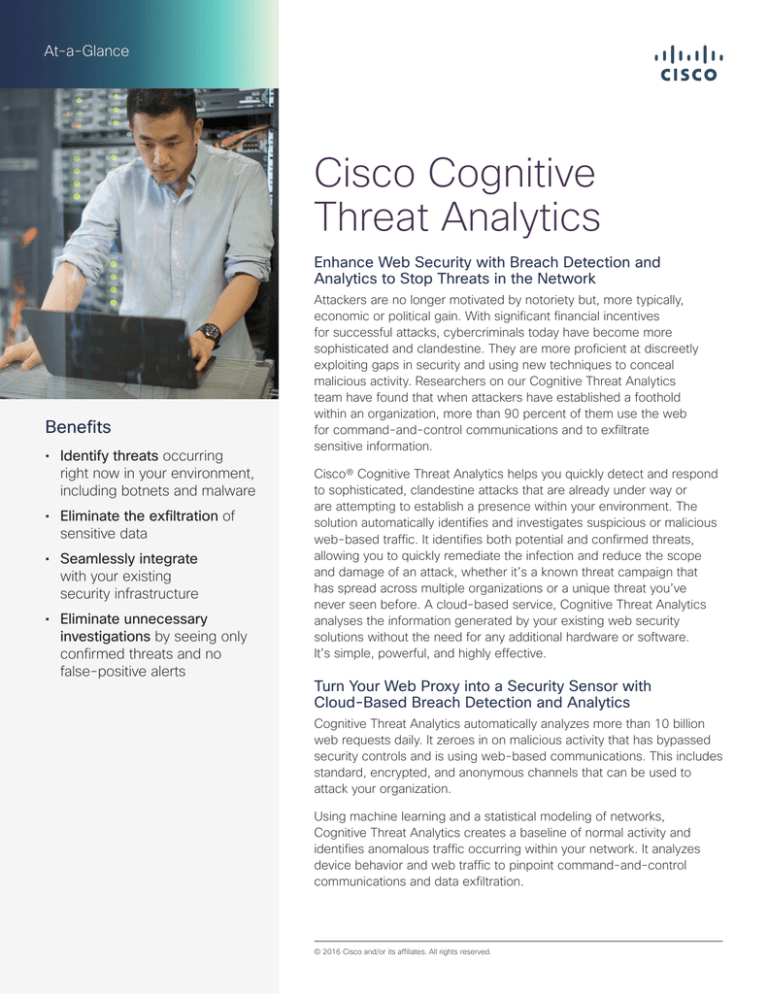
At-a-Glance
Cisco Cognitive
Threat Analytics
Enhance Web Security with Breach Detection and
Analytics to Stop Threats in the Network
Benefits
• Identify threats occurring
right now in your environment,
including botnets and malware
• Eliminate the exfiltration of
sensitive data
• Seamlessly integrate
with your existing
security infrastructure
• Eliminate unnecessary
investigations by seeing only
confirmed threats and no
false-positive alerts
Attackers are no longer motivated by notoriety but, more typically,
economic or political gain. With significant financial incentives
for successful attacks, cybercriminals today have become more
sophisticated and clandestine. They are more proficient at discreetly
exploiting gaps in security and using new techniques to conceal
malicious activity. Researchers on our Cognitive Threat Analytics
team have found that when attackers have established a foothold
within an organization, more than 90 percent of them use the web
for command-and-control communications and to exfiltrate
sensitive information.
Cisco® Cognitive Threat Analytics helps you quickly detect and respond
to sophisticated, clandestine attacks that are already under way or
are attempting to establish a presence within your environment. The
solution automatically identifies and investigates suspicious or malicious
web-based traffic. It identifies both potential and confirmed threats,
allowing you to quickly remediate the infection and reduce the scope
and damage of an attack, whether it’s a known threat campaign that
has spread across multiple organizations or a unique threat you’ve
never seen before. A cloud-based service, Cognitive Threat Analytics
analyses the information generated by your existing web security
solutions without the need for any additional hardware or software.
It’s simple, powerful, and highly effective.
Turn Your Web Proxy into a Security Sensor with
Cloud-Based Breach Detection and Analytics
Cognitive Threat Analytics automatically analyzes more than 10 billion
web requests daily. It zeroes in on malicious activity that has bypassed
security controls and is using web-based communications. This includes
standard, encrypted, and anonymous channels that can be used to
attack your organization.
Using machine learning and a statistical modeling of networks,
Cognitive Threat Analytics creates a baseline of normal activity and
identifies anomalous traffic occurring within your network. It analyzes
device behavior and web traffic to pinpoint command-and-control
communications and data exfiltration.
© 2016 Cisco and/or its affiliates. All rights reserved.
At-a-Glance
“[Cognitive Threat Analytics]
allows our team to work on the
projects that they need to be
working on instead of trying to
remediate threats.”
Scott Engle
Director of IT, Transplace
Detection and Analytics Engines
Detection and analytics features provided in Cognitive Threat Analytics
are shown in Table 1.
Table 1. Features of Cisco Cognitive Threat Analytics
Engine
What It Does
Data exfiltration
Cognitive Threat Analytics uses statistical modeling of an
organization’s network to identify anomalous web traffic
and pinpoint the exfiltration of sensitive data. It recognizes
data exfiltration even in HTTPS-encoded traffic, without any
need for you to decrypt transferred content.
Domain-generation
algorithm (DGA)
Attackers generate an arbitrary number of domain names
to avoid the detection and blacklisting of hosts that provide
malware. Cognitive Threat Analytics recognizes malicious
and obfuscated domain names generated from words,
analyzes the frequency of communication, the information
content of the headers, and hundreds of other features on
each HTTP or HTTPS request.
Exploit kit
Analyzing web requests allows Cognitive Threat Analytics
to uncover infections by exploit kits from (1) visits to an
infected webpage, (2) redirects of web requests to a
domain-hosting exploit kit, (3) unknowing downloads by
users, (4) successful exploitations, and (5) downloads of
malicious payloads.
Tunneling through HTTP
and HTTPS requests
Attackers often try to exfiltrate sensitive data, including
credentials, using HTTP and HTTPS requests themselves.
Cognitive Threat Analytics uses multiple indications of
compromise (IOCs), including global statistics and local
anomaly scores, to reliably distinguish malicious tunneling
from benign use of the technique.
Command-and-control
(C2) communication
Cognitive Threat Analytics combines a wide range of data,
ranging from statistics collected on an Internet-wide level
to host-specific local anomaly scores. Combining these
indicators inside the statistical detection algorithms allows
us to distinguish C2 communication from benign traffic and
from other malicious activities. Cognitive Threat Analytics
recognizes C2 even in HTTPS-encoded or anonymous
traffic, including Tor, without any need to decrypt transferred
content, detecting a broad range of threats.
Cisco Cognitive Threat Analytics serves up information through an
intuitive web-based portal, so users can quickly:
• Assess the severity and scope of intrusions
• Understand the mission of the threat and how it works
• Take immediate action
Learning from what it sees, Cognitive Threat Analytics adapts to provide
continuous breach identification, reducing the risk of repeat attacks or
continued infection.
Next Steps
For more information on Cisco Cognitive Threat Analytics,
visit www.cisco.com/go/cognitive to watch customer testimonials
and download detailed data sheets.
© 2016 Cisco and/or its affiliates. All rights reserved. Cisco and the Cisco logo are trademarks or registered trademarks of
Cisco and/or its affiliates in the U.S. and other countries. To view a list of Cisco trademarks, go to this URL: www.cisco.com/
go/trademarks. Third-party trademarks mentioned are the property of their respective owners. The use of the word partner
does not imply a partnership relationship between Cisco and any other company. (1110R)
C45-736555-00 01/16





